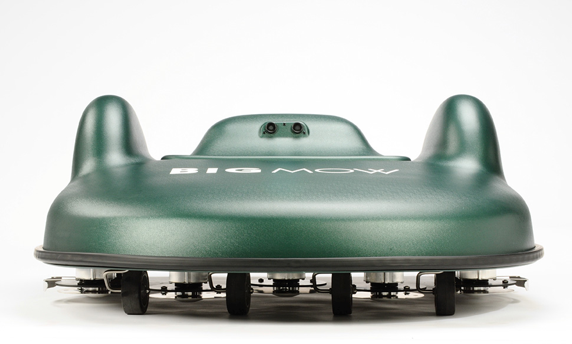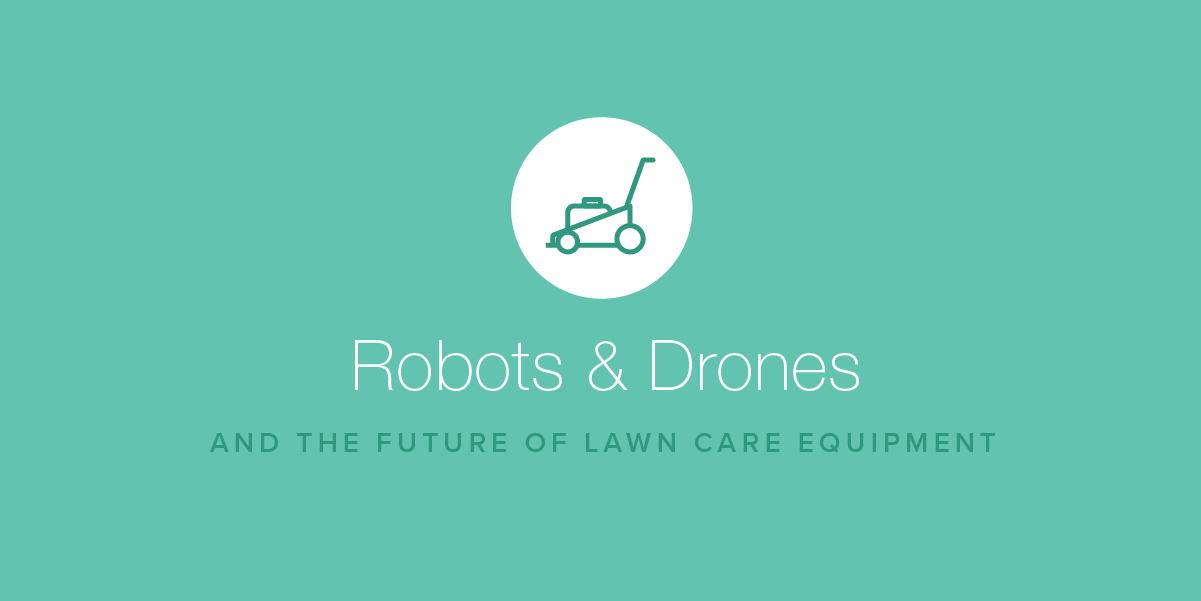Throwback: We predicted “The Future of Lawncare”
- September 12, 2024
- By: Vonigo
This post was originally published on September 12, 2017. It’s remarkable how well it holds up. While autonomous lawncare robots are not ubiquitous, they are certainly commonplace. The number of businesses offering tech-enabled lawncare services has skyrocketed. Here’s the original post from 2017, in its entirety, with no changes:
For lawn care businesses, the future has already arrived. Robotic lawn care equipment, lawn care software and a number of other automations are changing the game.
On paper, the landscaping and lawn care industries are booming. Demand is up, and businesses small and large are making decent profits. Nevertheless, many are having difficulty expanding. A lack of qualified help and plenty of competition are the main obstacles that stand in the way of growth. Administrative workflows also eat up valuable time and manpower.
Lawn care businesses looking for a way to get ahead may want to give automation a hard look. Robotic lawn mowers are poised to flip the industry upside down. Additionally, new lawn care software tools are making it easier for landscapers to get organized.
Read on to find out how automation can benefit your lawn care or landscaping business.

The Lawn Care Industry is Growing
In a recent survey from LawnStarter, 91% of lawn care service providers in the U.S. reported that they expect revenue to rise this year.
A good economy and high demand for services may be a big factor behind the optimistic consensus.
One additional factor could be that sales of new single family homes have been increasing every year since 2010 according to the United States Census Bureau. More new homes translates into increased demand for lawn care service.
But even without a real estate boom, prevailing attitudes and trends indicate that the demand for lawn services will likely continue to grow for years to come. Big opportunities may be in store for businesses that are willing and able to grow.
Nearly all (90%) of Americans that have lawns feel that it’s important to maintain their yard according to to an online questionnaire commissioned by the National Association of Landscape Professionals. Yet, many loathe the work involved that comes with the process. A 2015 survey from Briggs & Stratton indicates that 21% of Americans hate yard work or find it intimidating. Homeowners that don’t like to care for their lawns are creating opportunities for lawn care businesses.
The sheer amount of lawns that need mowing is also contributing to positive predictions for the lawn care industry. According to NASA satellite images, there are about 40 million acres of lawn in the United States.
Challenges and Obstacles
Even though high demand has created a landscaping boom, many providers are having a hard time picking up new clients. Recent surveys show that lack of qualified workers, on-the-job accidents and process inefficiency are three of the most pressing problems standing in the way.
Good Help is Hard to Find
Every year, Lawn & Landscape Magazine reaches out to their readers to learn about the current challenges facing professional yard work crews. And every year, personnel issues rank among the top concerns.
Common complaints about recruiting include:
- Very few potential recruits show up for job fairs and career days.
- Applicants lack vocational / technical training.
- Recruits lack interest in choosing yard care as a career.
- They are reluctant to perform manual labor.
- The unstable regulations around hiring foreign workers.
- Healthcare expenses.
Robotics tools and software automation platforms can provide a way for landscapers to grow without having to take on additional employees.
Paperwork Woes
The second problem landscapers face involves a chore that all small business owners must grapple with: paperwork.
Typical mundane administrative tasks that eat up time include:
- Managing client relationships
- Scheduling jobs
- Processing payments
- Issuing quotes
- Keeping track of inventory
All of these tasks can feel overwhelming at times. And if you’re using several different software platforms to accomplish them, odds are high that important details are slipping through the cracks. A purpose-built lawn care software solution can go a long way towards shoring up those inefficiencies.
A Robot-Powered Lawn Care Startup
Even though several different types of robotic lawn tools are out there, few landscaping business are actually investing in robotics. But Robin — a lawn care startup from Texas — has made robotics a central part of its strategic game plan.
“We’ll have these branded mowers, we’re going straight to the manufacturer and basically buying them wholesale. We come in and say let us install it, and then we’ll lease it to you for less than what you would pay for weekly mowing from a lawn service.” – Robin Co-founder Justin Crandall
Robin’s business model addresses the primary reasons why robotic mowers haven’t caught on in the United States.
- Robotic lawn mowers are still pricey compared to push mowers.
- They can be tricky to install on some types of lawns.
By eliminating setup hassles and reducing expenses down to a small monthly fee, Robin is poised to bring robotic lawn mowers into the mainstream. In addition to leasing and setting up robotic mowers, Robin also offers traditional lawn care service add-on packages.
Robotic Lawn Mowers
Robin’s example proves that robotic tools are already changing the way that landscapers do business. Let’s take a look at a few of the most popular commercial and residential robotic lawn mower brands out there right now.
Commercial
BigMow. When it comes to commercial robot mowers, BigMow reigns supreme. On its website, BigMow brags that it has the “most powerful robotic mower in the world.” Belrobotics’ flagship robo-mower can handle steep 45% (24 degree) slopes and can cover 5 acres worth of grass. It’s also equipped with sonar sensors that help it avoid knocking into fences, tree stumps and other obstacles.

MowBotix. If things keep looking up for MowBotix, BigMow might soon face some stiff competition. Instead of building actual robotic mowers from scratch, the founders of MowBotix have developed a system for converting ordinary riding lawnmowers into autonomous, driverless machines. RealCo – a group of investors from San Antonio – are betting that MowBotix is onto something, which is why they’ve recently put $100,000 into the company as part of the RealCo Seed Fund Program.
Residential
What’s interesting about Robin is that the company isn’t interested in expensive, commercial robotic mowers. Instead, it is buying consumer grade robotic mowers in bulk and leasing them out to its customers in exchange for a small monthly fee. Consumer robotic lawn mowers have come a long way in recent years, but you have to shell out around $1000 to buy one. As a result of the high cost to get started, people are still a bit hesitant to take to plunge. However, landscapers that follow Robin’s business model could help bridge the gap.
Husqvarna. Husqvarna’s Automower is the most advanced robotic lawnmower in the consumer market right now. Though Automower isn’t quite as strong or as full-featured as BigMow, it can still handle 1.25 acres worth of grass and 45% (24 degree) slopes. Instead of sonar, Automower uses shock sensors and GPS for navigation. It also comes equipped with self-charging capability, smartphone integration, fold away blades, an anti-theft alert system and more.
Worx. Worx’s Landroid stands out because it’s a sub-$1000 robotic mower that can easily go toe to toe with Honda’s overhyped, overpriced Miimo. Even though Landroid is cheap compared to brand name robotic mowers, it has an impressive three year warranty, plus it delivers a very nice cut on flat surfaces and is super easy to setup. In 2015, Landroid made Consumer Reports’ Most Innovative Home Products list for its excellent cutting performance and reasonable price tag.
Automating Your Paperwork
Robotic mowers can help you save time and energy when it comes to tasks involving physical labor. But for paperwork help, smart cloud-based software suites are the way to go.
In terms of the efficiency it can create, lawn care software may be the single best investment that companies can make. You can access it from anywhere you have an internet connection. With one tool you can: accept online bookings, confirm and schedule the job, and send an invoice. Lawn care software helps streamline processes and save time every step of the way.
Scheduling, dispatching, invoicing and payment information is collected and organized into one centralized database. This streamlined approach to data management creates a far more seamless experience compared to using a different piece of software for every administrative task.
Online Booking
Give your customers the ability to book any time they want online. All they have to do is pull up your website and fill in a secure form.
Job Scheduling
All data collected feeds directly into a calendar system. This makes it easy to sort out your schedule if you have a number of separate landscaping teams working jobs at several different locations.
Easy to Expand
Once you’re ready to grow, lawn care software scales with your business and mitigates the hassle involved in managing an expansion. Its centralized database makes it easy to manage large teams and inventories.
Save Time, Be More Productive
All that time and energy you use to sort out your paperwork and accomplish mundane tasks can be redirected into more productive avenues.
According to Lawn & Landscape’s latest annual landscaping industry report, maintenance is still the biggest moneymaker. However, design and build services are catching up. Homeowners don’t want their lawns to look like everyone else’s. They want unique landscaping and outdoor living features added to their lawns.
If you plan on adding to your menu of services to keep up with landscaping trends, you’ll need more resources. Manual labor and administrative tasks are time drains. But if you automate all tasks that a robot or software platform can take care of for you, you’ll be in a better position to take your business to the next level.
What’s Next in Lawn Care?
In the future will landscapers be able to unleash an army of specialized robots on their customers’ lawns and order them around with their smartphones? Or will hulking, all-in-one landscaping robots become the biggest design trend?
New York startup The Kobi Company is betting that large, multi-purpose bots are the future of landscaping. It’s developing a powerful, heavy duty bot that’s designed to handle a variety of landscaping jobs. Their eponymous flagship robot Kobi can cut grass, blow leaves and even monitor the weather via the internet to find out when it’s time to switch into plow mode.
When in lawn mowing mode, Kobi can cover a whopping seven acres worth of lawn territory. Other modes, however, are somewhat more limited. Kobi can only cover 0.37 acres when plowing snow, and three acres when blowing leaves.
Kobi is designed to cater to consumer needs, but the company’s CEO seems to have his eye on the commercial market. When Kobi CEO Andrew Ewen unveiled the Kobi robot in October of 2016, he mentioned that commercial snow removal services had expressed interest in buying a commercial version of his product. Right now, Ewen is waiting to see if the residential version will catch on. But if Kobi is successful, large multi-purpose landscaping robots might soon become a key part of every landscaper’s toolkit.
Summary
The landscaping industry is hot, but businesses are struggling to keep up with demand. Surveys indicate that employers often complain about the workforce. However, health and safety risks, as well as inefficient business processes, are also a concern. Automation provides a way to offset some of the pain caused by these issues. Several good robotic lawn mowers are already available, and cloud-based lawn care software automation platforms like Vonigo can also provide resource management help.
Want to know more about how lawn care software can help your business earn more profits and grow? Book a free, private demo of Vonigo.




